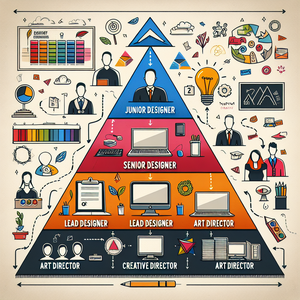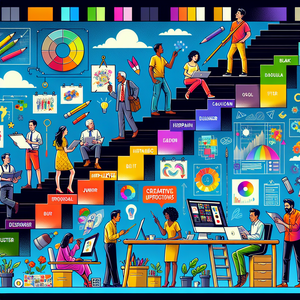
Understanding the Design Job Title Hierarchy: A Detailed Career Guide
The design industry is an ever-evolving domain filled with numerous career opportunities that span various specializations, such as graphic design, product design, user experience (UX), and interior design. As organizations increasingly prioritize design in their strategies, having a clear understanding of the hierarchy of design job titles, along with the unique responsibilities associated with each role, is crucial for anyone aiming to carve out a successful career in this field. This guide seeks to unravel the complexities of various design positions, highlighting their functions, necessary skills, and potential career paths. By examining both leadership roles and specialized tasks, readers will gain a comprehensive view of how each title fits into the larger design ecosystem, empowering them to make informed career decisions.
Job Summaries:
Chief Design Officer (CDO):
- The CDO oversees all design initiatives within an organization.
- This role demands a profound understanding of design strategy, user experience, and brand integrity.
- The CDO works closely with other C-suite executives.
- Aligning design goals with overarching business objectives is a key responsibility.
- Strong leadership skills are essential for this position.
- Extensive industry experience is typically required.
- A degree in design or a related field is often necessary.
Design Director:
- At the helm of design teams, Design Directors manage the entire design process on projects.
- They set the creative vision, mentor junior designers, and uphold high design standards.
- A robust portfolio and leadership experience, along with a degree in design, are necessary, as they bridge the gap between executive management and creative teams.
Senior Product Designer:
- Senior Product Designers focus on creating products that prioritize user experience and visual appeal.
- They collaborate across teams to develop and iterate on designs.
- Proficiency in design software and user-centered design principles is vital for success in this role.
- Several years of experience and a bachelor's degree in design are also important.
UX/UI Designer:
- Specializing in user interface design for digital platforms
- Conduct user research
- Create wireframes
- Prototype designs to enhance user experience
- Mastery of design tools is essential
- A related degree is essential
- Their work significantly influences digital product usability
Graphic Designer:
- Tasked with producing visual content for branding and marketing.
- Graphic Designers create artwork, layouts, and typography.
- Expertise in design software like Adobe Creative Suite is crucial.
- A degree in graphic design is often required.
- They shape a company’s visual identity.
Art Director:
- Art Directors guide the visual aspects of advertising and marketing campaigns.
- They oversee creative teams to ensure that visual narratives align with brand goals.
- This necessitates strong leadership and a degree in art or design.
Interior Designer:
- Interior Designers create functional and aesthetically pleasing spaces for clients.
- They assess needs, develop design concepts, and select materials while adhering to regulations.
- A degree in interior design and relevant certifications are typically required, highlighting their role in enhancing usability and aesthetics.
Junior Product Designer:
- Junior Product Designers support experienced designers by creating prototypes and conducting user tests.
- A design degree and familiarity with design software are prerequisites.
- This entry-level role is crucial for skill development in the field.
Visual Designer:
- Focusing on the visual elements of digital products.
- Visual Designers ensure designs are both attractive and functional.
- A degree in visual design and experience with design software are generally required for this role.
- This role contributes to user engagement and brand recognition.
Motion Graphics Designer:
- Creating animated visuals
- Motion Graphics Designers use animation software to bring designs to life
- A degree in graphic design or animation is essential
- A strong portfolio is essential for this engaging position
Creative Director:
- Creative Directors oversee the overall creative vision of projects.
- Managing teams and ensuring brand alignment.
- Extensive experience in creative roles and a strong portfolio are essential for this leadership position.
- A degree in design or art is often supported for this role.
User Experience Researcher:
- User Experience Researchers gather insights into user behaviors and needs to inform the design process.
- A background in psychology or a related field is generally required.
- Strong analytical skills are important.
- Emphasizes the importance of user-centered design.
Freelance Graphic Designer:
- Operating independently
- Handle client relationships
- Manage project timelines
- Strong portfolio is vital
- Self-promotion skills are essential
- Offer flexibility
- Provide creative freedom within the industry
Web Designer:
- Web Designers enhance the visual layout of websites.
- They apply responsive design principles to improve user experience.
- Proficiency in HTML, CSS, and design software is typically necessary.
- A degree in web design or a related field is typically necessary.
Fashion Designer:
- Fashion Designers create garments and accessories
- Blending aesthetics with functionality and market trends
- A degree in fashion design is critical
- A robust portfolio is critical for influencing consumer preferences
Brand Designer:
- Focused on developing a brand's visual identity
- Brand Designers create logos, typography, and color schemes
- Strong graphic design skills are crucial
- A degree in design is important
- Helps establish a cohesive brand image
Product Design Intern:
- As entry-level contributors, Product Design Interns assist with various design tasks.
- Gaining valuable hands-on experience.
- A background in design studies is generally required.
- This role is essential for building foundational skills.
Industrial Designer:
- Industrial Designers conceptualize and create manufactured products.
- They enhance functionality and aesthetics.
- A degree in industrial design is essential.
- Proficiency in CAD software is essential.
- Their work directly impacts product usability.
Visual Effects Artist:
- These artists create realistic animations for various media using specialized software.
- A degree in animation or visual effects and a strong portfolio are typically needed for this impactful role.
Design Researcher:
- Design Researchers collect and analyze insights about user needs and behaviors.
- Employ various methodologies to inform design decisions.
- A background in research or design is beneficial.
- This role ensures that solutions are user-focused and effective.
The design field is rich with diverse opportunities across numerous specializations, with each role contributing uniquely to the overall creative industry. By grasping the hierarchy and specific responsibilities connected to each design job title, aspiring professionals can navigate their career paths with greater ease and confidence. This understanding not only prepares them to meet the demands of an evolving industry but also positions them for success in their chosen specialties. To explore current openings in these exciting design roles, consider seeking opportunities that align with your skills and interests, paving the way for a fulfilling career in design.
Explore More Jobs

